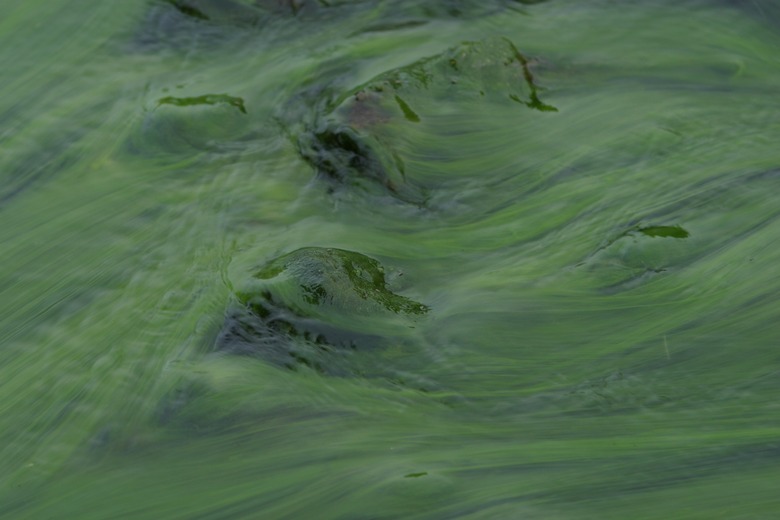What Is The Shape Of A Cladophora's Chloroplasts?
If you've ever visited a body of water or even peered into a fish tank, you are probably familiar with green algae.
These organisms, which are also called chlorophytes since they can use the sun's energy to make chemical energy, include the common green algae species from the genera Hydrodictyon and Chlorella.
One other genus of green algae – Cladophora – intrigues scientists because of its interesting structure and because it sometimes causes problems for people who live near the lakes and streams in which it grows.
TL;DR (Too Long; Didn't Read)
_Cladophora_ is a genus of green algae that uses photosynthesis to produce chemical energy from sunlight it captures with its chloroplast organelles. These chloroplasts are parietal and reticulate, which means they lie near the cell wall and take the shape of cylindrical nets.
What Is Cladophora?
What Is Cladophora?
Cladophora is a branching, filamentous green algae sometimes called "pin cushion algae." Its filaments are brownish-green, wiry to the touch and, upon close inspection, segmented. Cladophora filaments are usually three to four inches long but may grow much longer.
While some Cladophora species live in the world's oceans, most are freshwater dwellers. These freshwater Cladophora prefer shallow lakes or streams with rocks or branches to which they cling. Although individual filaments are long and hair-like, waves in the water can roll the algae into balls.
Some people call these marimo balls, although the most trendy marimo balls kept as aquatic houseplants were recently re-classed into a different genus after extensive genetic analysis.
Ecological Impact of Cladaphora
Ecological Impact of Cladaphora
Environmental scientists consider some species of Cladophora – notably Cladophora glomerata – nuisance organisms. This is especially true on the Great Lakes where the algal mats can clog fishing nets or wash ashore, where they decay and give off an odor like raw sewage. Cladophora may also contribute to the spike in invasive mussel populations, which wash up with the algae and attract sea gulls.
This compounds the bacterial problem on the lakes' beaches and can reduce recreation in the area as well as local property values.
On the flip side, Cladophora is otherwise harmless and serves important ecological functions. These include being a source of food for fish and aquatic animals as well as offering protection from the sun's ultraviolet rays for organisms that use Cladophora mats like an umbrella. In some parts of Southeast Asia, Cladophora is a delicacy commonly known as "Mekong weed."
What Are Chloroplasts?
What Are Chloroplasts?
All living things need energy. Some organisms – such as algae, cyanobacteria and plants – can use the energy of the sun to convert carbon dioxide and water into oxygen and sugar. They release the oxygen into the atmosphere (for you to breathe) and use the sugar to meet immediate energy needs or store it for later.
These photoautotrophs rely on specialized, pigmented organelles called chloroplasts. These organelles derive their green color from the pigments chlorophyll a and chlorophyll b. The chlorophylls participate in the first half of photosynthesis – the light-dependent reactions – by collecting the necessary sunlight and setting off a series of complex chemical reactions that set the stage for sugar formation.
Cladophora’s Parietal Chloroplast
Cladophora's
Parietal Chloroplast
The location and shape of the chloroplast in green algae sets them apart. While non-algal plants, such as those terrestrial species most commonly associated with the word "plant," all have cone-shaped chloroplasts, the organelles are much more diverse among algae species. They can be round, oval, spiral or even shaped like cups or stars.
The chloroplasts of Cladophora are parietal, which means they are near the cell wall at the cell's exterior. Cladophora chloroplasts are also reticulate. This means that lots of tiny chloroplasts pack together into a cylindrical net.
Cite This Article
MLA
Mayer, Melissa. "What Is The Shape Of A Cladophora's Chloroplasts?" sciencing.com, https://www.sciencing.com/shape-cladophoras-chloroplasts-16822/. 17 June 2019.
APA
Mayer, Melissa. (2019, June 17). What Is The Shape Of A Cladophora's Chloroplasts?. sciencing.com. Retrieved from https://www.sciencing.com/shape-cladophoras-chloroplasts-16822/
Chicago
Mayer, Melissa. What Is The Shape Of A Cladophora's Chloroplasts? last modified March 24, 2022. https://www.sciencing.com/shape-cladophoras-chloroplasts-16822/
